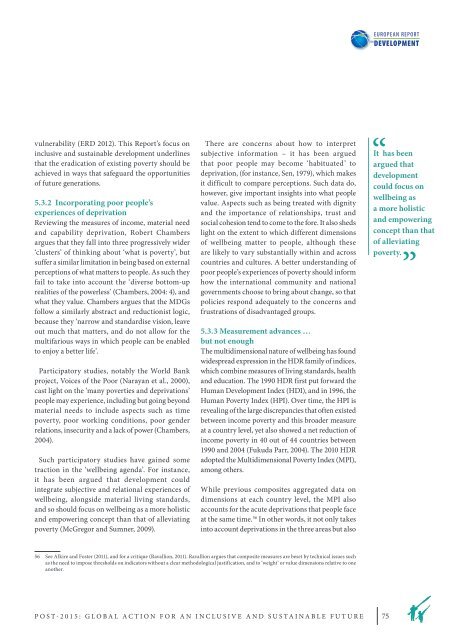Post 2015: Global Action for an Inclusive and Sustainable Future
Post 2015: Global Action for an Inclusive and Sustainable Future
Post 2015: Global Action for an Inclusive and Sustainable Future
You also want an ePaper? Increase the reach of your titles
YUMPU automatically turns print PDFs into web optimized ePapers that Google loves.
vulnerability (ErD 2012). this report’s focus on<br />
inclusive <strong>an</strong>d sustainable development underlines<br />
that the eradication of existing poverty should be<br />
achieved in ways that safeguard the opportunities<br />
of future generations.<br />
5.3.2 Incorporating poor people’s<br />
experiences of deprivation<br />
reviewing the measures of income, material need<br />
<strong>an</strong>d capability deprivation, robert chambers<br />
argues that they fall into three progressively wider<br />
‘clusters’ of thinking about ‘what is poverty’, but<br />
suffer a similar limitation in being based on external<br />
perceptions of what matters to people. as such they<br />
fail to take into account the ‘diverse bottom-up<br />
realities of the powerless’ (chambers, 2004: 4), <strong>an</strong>d<br />
what they value. chambers argues that the mDGs<br />
follow a similarly abstract <strong>an</strong>d reductionist logic,<br />
because they ‘narrow <strong>an</strong>d st<strong>an</strong>dardise vision, leave<br />
out much that matters, <strong>an</strong>d do not allow <strong>for</strong> the<br />
multifarious ways in which people c<strong>an</strong> be enabled<br />
to enjoy a better life’.<br />
participatory studies, notably the World b<strong>an</strong>k<br />
project, voices of the poor (naray<strong>an</strong> et al., 2000),<br />
cast light on the ‘m<strong>an</strong>y poverties <strong>an</strong>d deprivations’<br />
people may experience, including but going beyond<br />
material needs to include aspects such as time<br />
poverty, poor working conditions, poor gender<br />
relations, insecurity <strong>an</strong>d a lack of power (chambers,<br />
2004).<br />
Such participatory studies have gained some<br />
traction in the ‘wellbeing agenda’. For inst<strong>an</strong>ce,<br />
it has been argued that development could<br />
integrate subjective <strong>an</strong>d relational experiences of<br />
wellbeing, alongside material living st<strong>an</strong>dards,<br />
<strong>an</strong>d so should focus on wellbeing as a more holistic<br />
<strong>an</strong>d empowering concept th<strong>an</strong> that of alleviating<br />
poverty (mcGregor <strong>an</strong>d Sumner, 2009).<br />
there are concerns about how to interpret<br />
subjective in<strong>for</strong>mation – it has been argued<br />
that poor people may become ‘habituated’ to<br />
deprivation, (<strong>for</strong> inst<strong>an</strong>ce, Sen, 1979), which makes<br />
it difficult to compare perceptions. Such data do,<br />
however, give import<strong>an</strong>t insights into what people<br />
value. aspects such as being treated with dignity<br />
<strong>an</strong>d the import<strong>an</strong>ce of relationships, trust <strong>an</strong>d<br />
social cohesion tend to come to the <strong>for</strong>e. It also sheds<br />
light on the extent to which different dimensions<br />
of wellbeing matter to people, although these<br />
are likely to vary subst<strong>an</strong>tially within <strong>an</strong>d across<br />
countries <strong>an</strong>d cultures. a better underst<strong>an</strong>ding of<br />
poor people’s experiences of poverty should in<strong>for</strong>m<br />
how the international community <strong>an</strong>d national<br />
governments choose to bring about ch<strong>an</strong>ge, so that<br />
policies respond adequately to the concerns <strong>an</strong>d<br />
frustrations of disadv<strong>an</strong>taged groups.<br />
5.3.3 Measurement adv<strong>an</strong>ces …<br />
but not enough<br />
the multidimensional nature of wellbeing has found<br />
widespread expression in the HDr family of indices,<br />
which combine measures of living st<strong>an</strong>dards, health<br />
<strong>an</strong>d education. the 1990 HDr first put <strong>for</strong>ward the<br />
Hum<strong>an</strong> Development Index (HDI), <strong>an</strong>d in 1996, the<br />
Hum<strong>an</strong> poverty Index (HpI). over time, the HpI is<br />
revealing of the large discrep<strong>an</strong>cies that often existed<br />
between income poverty <strong>an</strong>d this broader measure<br />
at a country level, yet also showed a net reduction of<br />
income poverty in 40 out of 44 countries between<br />
1990 <strong>an</strong>d 2004 (Fukuda parr, 2004). the 2010 HDr<br />
adopted the multidimensional poverty Index (mpI),<br />
among others.<br />
While previous composites aggregated data on<br />
dimensions at each country level, the mpI also<br />
accounts <strong>for</strong> the acute deprivations that people face<br />
at the same time. 56 In other words, it not only takes<br />
into account deprivations in the three areas but also<br />
56 See alkire <strong>an</strong>d Foster (2011), <strong>an</strong>d <strong>for</strong> a critique (ravallion, 2011). ravallion argues that composite measures are beset by technical issues such<br />
as the need to impose thresholds on indicators without a clear methodological justification, <strong>an</strong>d to ‘weight’ or value dimensions relative to one<br />
<strong>an</strong>other.<br />
poSt-<strong>2015</strong>: <strong>Global</strong> actIon For <strong>an</strong> IncluSIvE <strong>an</strong>D SuStaInablE FuturE<br />
It has been<br />
argued that<br />
development<br />
could focus on<br />
wellbeing as<br />
a more holistic<br />
<strong>an</strong>d empowering<br />
concept th<strong>an</strong> that<br />
of alleviating<br />
poverty.<br />
75

















